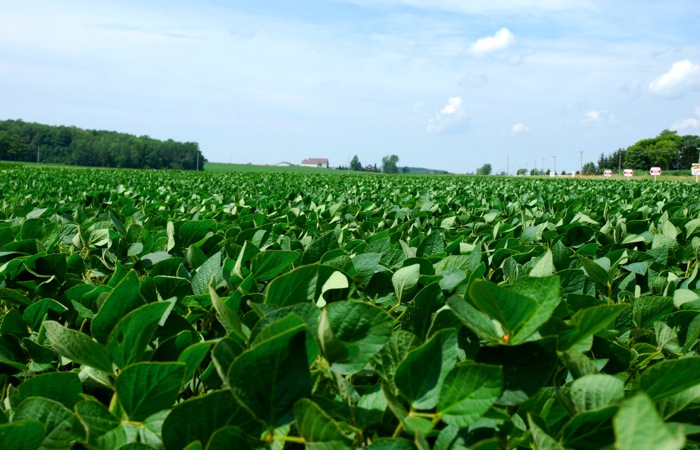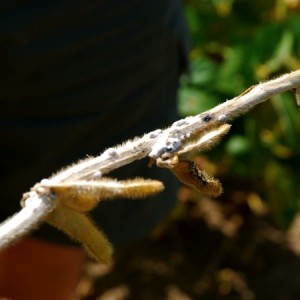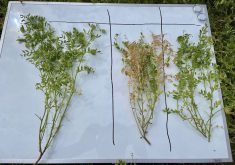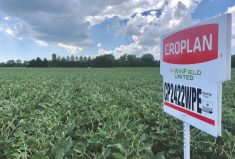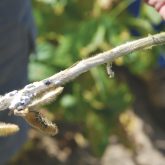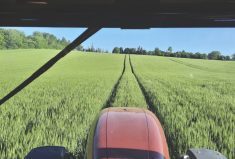Sometimes it’s best to take a quick look in the rear-view mirror before considering where to go next. In farming, of course, it isn’t that simple. The weather next year will never be exactly the same as it was this year, and pest and disease pressures will vary too.
Still, it’s essential to look for lessons, and if the 2014 growing season has taught farmers, retailers and extension personnel anything, it’s that planting conditions and cool summer weather can combine in the worst ways.
Read Also

Sensing the soil: Root cell research finds ‘stress hormone’
Research into how root cells react to soil stressors could help plants better adapt to changes in their climate.
In turn, that means the big lesson this year is all about the risk of lower seed populations.
Seeding rates
Seeding rates have been a hot topic for the past three to five years. Then, with a drop in soybean prices in the forecasts last spring, many growers shaved their rates in order to cut their production costs.
Yet cutting your seeding rate isn’t for the faint of heart, and Horst Bohner for one isn’t a strong advocate of the practice.
Bohner understands the theory — beans are genetically good at compensating for low populations — and under ideal conditions, he says, it’s always good to keep an open mind about basic practices like populations.
But Bohner, soybean specialist for the Ontario agriculture ministry says this year, conditions weren’t at all ideal in most fields.
“You can solve a lot of agronomic problems by simply increasing the seeding rate or keeping it at a relatively high rate,” says Bohner. “An acre of land needs a certain minimum number of plants for maximum yields. If you fall below that, you will give up yield.
“By keeping seeding rates reasonably high,” Bohner explains, “you increase the chances of an acceptable stand. Problems associated with soil crusting, poor depth control, excess corn residue, insect feeding or a little bit of phytophthora are reduced by putting down enough seed.”
Yes, he adds, under ideal conditions and a long growing season, and by selecting the best tall and bushy variety for a specific zone or field, it’s possible for a grower to get away with a lower plant density.
“But this 2014 growing season is a perfect example of why it doesn’t always work,” says Bohner. “We had problems with plant stands, and with pod-set per plant.
“What we care about is the number of seeds per acre and the size of the seed. We don’t care about how many plants you have out there, but if every plant can only bear so much in a given year…”
So when planting rates go down, each of the plants is responsible for an even larger share of the overall yield, and there are also fewer plants to fight against any of the challenges that are almost bound to come up.
In other words, you’re heading into “whatever can go wrong will go wrong” territory.
Of course, fields can be overplanted too, especially where there’s a history of white mould, or when overplanting results in lodging.
“Within management strategies,” Bohner says, “there is a huge range, and there are producers who make lower populations work for them, and good on them — why not?”
But, he adds, just because it can sometimes happen doesn’t mean that it’s always a good idea: “It certainly takes a higher level of management when you get into those more unique strategies.”
The long and the short of it is that the growing season, even in extreme southwestern Ontario, is relatively short, and the goal is to capture as much sunlight as possible.
“If you go to wider rows and reduced populations, you just don’t have the leaf area to catch the sunlight,” Bohner says.
Diseases – east and west
As might be expected, sclerotinia (white mould) has been a problem both in eastern Ontario and in the southwest this year. For Clare Kinlin, sclerotinia is a constant issue in the east, one that was so bad in 2014 that in some fields he could see it from the highway.
Unfortunately, Kinlin says, the disease isn’t likely to go away any time soon, given the trend in rotation practices.
“We’re growing more and more soybeans every year,” says Kinlin, sales manager of the crop division for MacEwen Agricentre, based in Maxville, Ont. “We’re really starting to turn into a corn-soybean rotation.”
More beans in the rotation mean more pressure from white mould, especially in a moderately wet climate like eastern Ontario.
On the positive side though, growers are hungry for more information on how to overcome or compensate for the disease.
“They’re saying, ‘OK, we’re trying to get a tonne and a half out of these fields, so how do we get these beans to yield?’” says Kinlin. “There’s a real desire to get beans to yield, and the really frustrating part with soybeans is trying to get them to respond to anything.”
Plant populations in the region are generally 180,000 to 200,000, which was a slight increase for 2014. There’s also a greater tendency to move to 30-inch rows, a practice that’s gaining ground as more growers get rid of their drills and switch soybeans to their planters. The move is giving them better everything — better depth control, better emergence, better stands and less white mould.
“White mould is the big one, and it’s bad, it’s here to stay and that’s nothing new,” says Kinlin, setting his sights on 2015.
Asked if there’s anything to combat sclerotinia going forward into 2015, Kinlin says it all comes down to one thing: “Residue management — that first pass for next year is the combine this fall. We need to do a better job of (corn) residue management, in terms of spreading it or working it in uniformly and consistently. With 200-bushel corn and that leaves a lot of residue, and beans struggle with that.”
Six-hours’ drive west and south, Dave Curry faced the same problem in 2014. As agronomist with Parkland Farms near Sarnia, Ont., Curry oversees the operation of several thousand acres each year. And like Kinlin, he’s seen more white mould than he’d care to, although he would have expected to see more, given the cooler and wetter growing conditions this past year.
“We’re usually pretty good about planting the right variety in a field that we know has a history of white mould, where we tried to make sure we were going in with wider rows and actually planting with lower seeding populations, and planting a variety with a good genetic resistance to it,” says Curry.
Still, Parkland’s soybeans were largely planted during the last week of May and early June this year, so the crop wasn’t as lush and the onset of white mould was slower. “There was the odd pocket,” Curry says, “but I didn’t come across as much as I would have expected.”
Another sign of the cool, wet weather that Curry had to deal with was a higher-than-usual incidence of rhizoctonia on the wet spots that had some compaction issues in heavier clay. Despite the wetter-than-normal conditions, even in spite of the later planting, phytophthora wasn’t a problem, and sudden death syndrome was only an issue later in the season.
Curry was busy taking notes late in August, and mapping out the cropping plan for 2015, and perhaps eyeing 2016 in an effort to stem the spread of all of the diseases he saw.
“With certain diseases they’re going to last a lot longer,” says Curry, noting that the sclerotia associated with white mould can remain viable in the soil for years.
“It’s not a matter of if you rotate away for a couple of years, it’s gone,” Curry says. “We need to plan it longer term so that when we go back in with soybeans, we make the proper management decisions.”
Curry adds that it’d be great to be able to break the disease cycle completely by putting in a forage crop for three or four years, but for most growers, including his operation, that’s not an option. Many farmers he knows are moving to tighter rotations, although he’s maintaining his three-crop plan because he says he gets upwards of a five-bushel-per-acre yield rotational bump on his soybeans.
Curry also tries to manage the farming operation with very little tillage, yet he acknowledges there’s the temptation to bury the sclerotia associated with white mould, even to reduce the pressure for a year. But research from the U.S. suggests that given the long life of those mould spores, it’s possible that when you try to bury one year’s sclerotia, you bring other, still viable sclerotia back up to the surface.
Curry’s other concern is fungicide resistance. According to reports from the U.S., populations of two diseases, frogeye leaf spot and rhizoctonia have been confirmed to be resistant to strobilurins, and he’s watching that situation.
It’s still a long way from his Ontario ground, but Curry says that he knows of sugar beet farms in Lambton County and in Michigan that have run out of answers to the Cercospora resistance problem. And he wonders if its spread into soybeans closer to home isn’t just a matter of time.
This article was originally published as a Soybean Guide feature in the October 2014 issue of Country Guide


